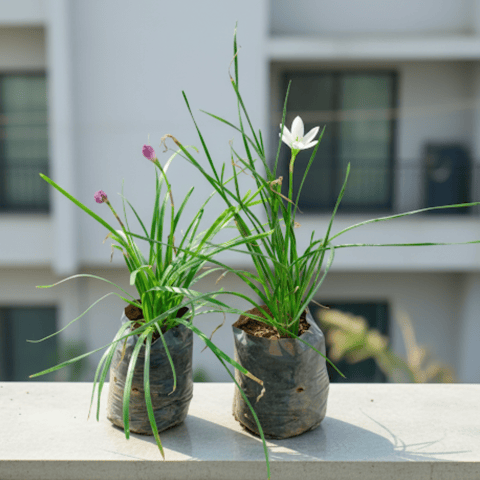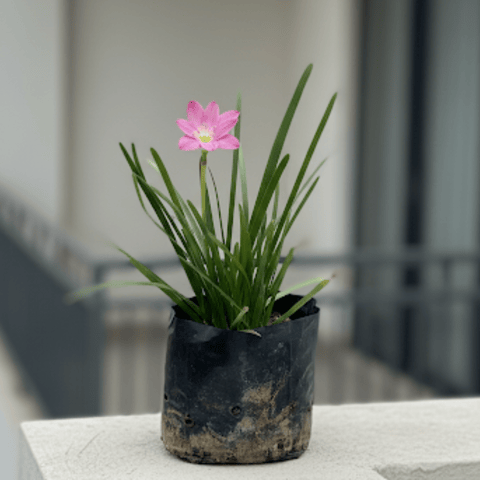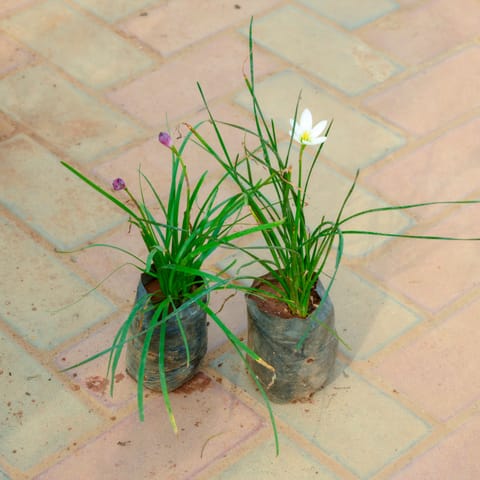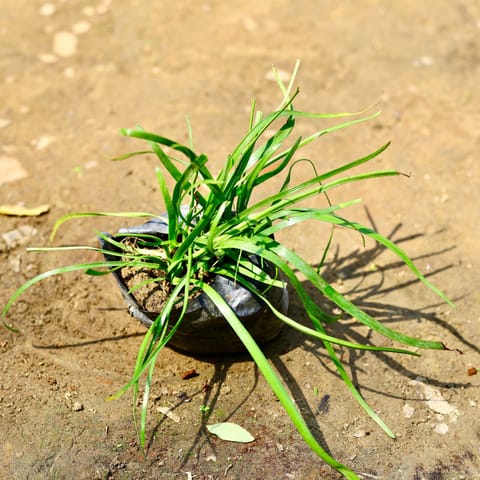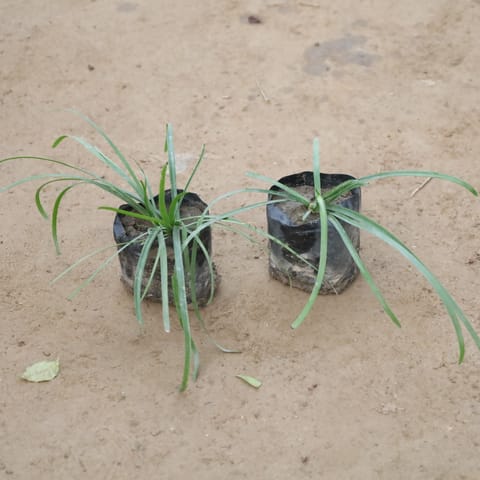Shop

Downalod our app
Search our catalog
Recent Search

Please provide your delivery pincode to see products available in your area
Recent Search
Are you sure you want to logout?
You will be logged out of your account
Your current session will end and you'll need to sign in again to access your account.
Rain Lily Plant
The Rain Lily, or Zephyranthes, is a delicate and enchanting plant renowned...
The Rain Lily, or Zephyranthes, is a delicate and enchanting plant renowned for its charming colours and beauty. It is a genus of temperate and tropical bulbous plants in the Amaryllis family, widely cultivated as ornamental. The Rain Lily plant produces a bounty of blooms all at once, filling the garden with splashes of colours everywhere. The plant's foliage is in the form of slender, grass-like leaves. The flowers bloom in many colours, such as white, pink, yellow, and purple, and last long.
These remarkable bulbs create stunning displays when planted in groups, making them perfect for borders, rock gardens, or containers. Rain Lilies are great for late season flower interest along borders, in rock gardens or containers, providing gardeners with beautiful blooms when many other plants are finishing their flowering season.
What are the Benefits of Rain Lily Plants?
The Rain lily plants are beautiful and have many benefits for the garden. These hardy bulbs offer numerous advantages that make them excellent choices for both novice and experienced gardeners.
Low Maintenance Garden Addition
Rain lilies are low-maintenance plants that require minimal care once established. These flowering plants grow in well-drained soil and are drought-tolerant, making them perfect for gardeners looking for easy-to-grow plants. Pink rain lily is a low-maintenance plant that thrives in warm climates with well-draining soil, requiring only basic care to produce stunning results.
If you want to grow plants from rain lily seeds, you must sow the seeds before the monsoon season. However, most gardeners find bulbs easier to establish and more reliable for consistent blooming.
Seasonal Blooms and Natural Beauty
These plants produce charming, trumpet-shaped flowers in various colours, including white, pink, yellow, and lavender. Their blooms are mainly seen after rainfall, hence the name "rain lily." They rely on occasional summer watering or natural heavy rainfall to initiate flowering, creating magical displays that appear almost overnight following rain showers.
The flowers typically last for several days, providing continuous colour throughout the growing season. Their grass-like foliage remains attractive even when the plant isn't flowering, adding texture and interest to garden beds.
Versatile Garden Applications
Rain lilies work beautifully in various garden settings. They're excellent for creating naturalistic plantings, adding colour to rock gardens, or providing late-season interest in perennial borders. Planted in clumps, they make for a spectacular sight once in flower, creating impressive displays that draw attention and admiration.
How to Grow and Care for Rain Lily Plants
Growing rain lilies successfully requires understanding their basic needs and providing appropriate growing conditions. These resilient bulbs reward gardeners with stunning displays when their simple requirements are met.
Ideal Growing Conditions for Rain Lilies
Rain lilies prefer full sun locations, ideally receiving six hours of sunlight or more, though they can tolerate partial shade. Plant your Rain Lilies in a location where the soil drains well and they will receive full sun for optimal flowering performance.
The soil should be well-draining, as waterlogged conditions can cause bulb rot. If you notice water puddles 5–6 hours after a hard rain, find another spot to plant. Slightly acidic to neutral soil works best for these adaptable plants.
Planting and Establishing Rain Lily Bulbs
Plant rain lily bulbs in spring after all danger of frost has passed. The top of the bulb should be about an inch under the soil surface and 2-4" apart (or closer in containers as they do best when crowded and slightly pot-bound). This close spacing creates more impressive displays and encourages better flowering.
Choose locations along walkways, in rock gardens, or in large drifts within perennial gardens where you need late-summer interest. The bulbs establish quickly and often bloom in their first season.
Care and Maintenance Requirements
Care for rain lily includes regular watering, even during dormancy, though they're quite drought-tolerant once established. Water regularly during the growing season, but allow the soil to dry between waterings.
Rain lily bulbs should not be moved until the bed is overcrowded, as they prefer to remain undisturbed for several years. This allows them to form attractive clumps that produce more impressive flowering displays.
Common Care Considerations
In extremely hot climates, plant where afternoon shade is available to the plant, especially in the hottest areas. This helps prevent stress and maintains flowering performance during intense summer heat.
The plants may go dormant during dry periods, but don't worry – they'll return to active growth when conditions improve. This natural cycle is part of their charm and adaptability.
Why Choose Urvann to Buy Rain Lily Plant Online?
Opt for Urvann to buy rain lily bulbs for sale at the most affordable prices and enjoy the pleasures of gardening without the hassle of transportation. We assure you of free next-day delivery of all your plants right to your doorstep in the best conditions. Our dedicated customer support team is just a call away for any queries on plant care or other issues, ensuring quick resolutions.
Premium Quality Bulbs
Our rain lily bulbs are carefully selected for quality and viability. Each bulb undergoes inspection to ensure you receive healthy, ready-to-grow specimens that will establish quickly in your garden. We source our bulbs from trusted growers who specialise in producing high-quality flowering bulbs.
Expert Growing Advice
Our experienced team provides comprehensive growing guides and ongoing support to help you succeed with your rain lily plants. Whether you're a beginner or experienced gardener, we're here to help you achieve the best results with your new plants.
Convenient Online Shopping
Browse our selection of rain lily varieties from the comfort of your home. Our user-friendly website makes it easy to compare different types and choose the perfect rain lilies for your garden. With detailed descriptions and growing information, you can make informed decisions about your purchase.
Reliable Delivery Service
We understand that timing matters when it comes to planting bulbs. Our efficient delivery system ensures your rain lily bulbs arrive in perfect condition and at the optimal time for planting in your garden.
FAQs
1. Where do Rain Lilies grow best?
As the name suggests, the Rain lily plant grows best in a location that receives rainfall frequently.
2. Is Rain Lily an indoor plant?
The Rain Lily is an outdoor flowering plant and cannot be grown indoors.
3. Does Rain Lily need sunlight?
Yes, the rain lily plant needs lots of sunlight to bloom.
4. Can we grow Rain Lilies in water?
The Rain Lily plant needs soil to grow, and so, the plant cannot grow in water.
5. When do Rain Lilies bloom?
Rain Lilies bloom after rainfall or heavy watering, producing their charming trumpet-shaped flowers mainly during the warmer months.
6. How long do Rain Lily flowers last?
Individual rain lily flowers usually last about 3 to 5 days, but the plants produce successive blooms throughout the growing season, providing extended colour in the garden.
7. Are Rain Lilies deer resistant?
Yes, Rain Lilies are generally deer resistant, making them excellent choices for gardens where deer browsing is a concern.
The Rain Lily, or Zephyranthes, is a delicate and enchanting plant renowned for its charming colours and beauty. It is a genus of temperate and tropical bulbous plants in the Amaryllis family, widely cultivated as ornamental. The Rain Lily plant produces a bounty of blooms all at once, filling the garden with splashes of colours everywhere. The plant's foliage is in the form of slender, grass-like leaves. The flowers bloom in many colours, such as white, pink, yellow, and purple, and last long.
These remarkable bulbs create stunning displays when planted in groups, making them perfect for borders, rock gardens, or containers. Rain Lilies are great for late season flower interest along borders, in rock gardens or containers, providing gardeners with beautiful blooms when many other plants are finishing their flowering season.
What are the Benefits of Rain Lily Plants?
The Rain lily plants are beautiful and have many benefits for the garden. These hardy bulbs offer numerous advantages that make them excellent choices for both novice and experienced gardeners.
Low Maintenance Garden Addition
Rain lilies are low-maintenance plants that require minimal care once established. These flowering plants grow in well-drained soil and are drought-tolerant, making them perfect for gardeners looking for easy-to-grow plants. Pink rain lily is a low-maintenance plant that thrives in warm climates with well-draining soil, requiring only basic care to produce stunning results.
If you want to grow plants from rain lily seeds, you must sow the seeds before the monsoon season. However, most gardeners find bulbs easier to establish and more reliable for consistent blooming.
Seasonal Blooms and Natural Beauty
These plants produce charming, trumpet-shaped flowers in various colours, including white, pink, yellow, and lavender. Their blooms are mainly seen after rainfall, hence the name "rain lily." They rely on occasional summer watering or natural heavy rainfall to initiate flowering, creating magical displays that appear almost overnight following rain showers.
The flowers typically last for several days, providing continuous colour throughout the growing season. Their grass-like foliage remains attractive even when the plant isn't flowering, adding texture and interest to garden beds.
Versatile Garden Applications
Rain lilies work beautifully in various garden settings. They're excellent for creating naturalistic plantings, adding colour to rock gardens, or providing late-season interest in perennial borders. Planted in clumps, they make for a spectacular sight once in flower, creating impressive displays that draw attention and admiration.
How to Grow and Care for Rain Lily Plants
Growing rain lilies successfully requires understanding their basic needs and providing appropriate growing conditions. These resilient bulbs reward gardeners with stunning displays when their simple requirements are met.
Ideal Growing Conditions for Rain Lilies
Rain lilies prefer full sun locations, ideally receiving six hours of sunlight or more, though they can tolerate partial shade. Plant your Rain Lilies in a location where the soil drains well and they will receive full sun for optimal flowering performance.
The soil should be well-draining, as waterlogged conditions can cause bulb rot. If you notice water puddles 5–6 hours after a hard rain, find another spot to plant. Slightly acidic to neutral soil works best for these adaptable plants.
Planting and Establishing Rain Lily Bulbs
Plant rain lily bulbs in spring after all danger of frost has passed. The top of the bulb should be about an inch under the soil surface and 2-4" apart (or closer in containers as they do best when crowded and slightly pot-bound). This close spacing creates more impressive displays and encourages better flowering.
Choose locations along walkways, in rock gardens, or in large drifts within perennial gardens where you need late-summer interest. The bulbs establish quickly and often bloom in their first season.
Care and Maintenance Requirements
Care for rain lily includes regular watering, even during dormancy, though they're quite drought-tolerant once established. Water regularly during the growing season, but allow the soil to dry between waterings.
Rain lily bulbs should not be moved until the bed is overcrowded, as they prefer to remain undisturbed for several years. This allows them to form attractive clumps that produce more impressive flowering displays.
Common Care Considerations
In extremely hot climates, plant where afternoon shade is available to the plant, especially in the hottest areas. This helps prevent stress and maintains flowering performance during intense summer heat.
The plants may go dormant during dry periods, but don't worry – they'll return to active growth when conditions improve. This natural cycle is part of their charm and adaptability.
Why Choose Urvann to Buy Rain Lily Plant Online?
Opt for Urvann to buy rain lily bulbs for sale at the most affordable prices and enjoy the pleasures of gardening without the hassle of transportation. We assure you of free next-day delivery of all your plants right to your doorstep in the best conditions. Our dedicated customer support team is just a call away for any queries on plant care or other issues, ensuring quick resolutions.
Premium Quality Bulbs
Our rain lily bulbs are carefully selected for quality and viability. Each bulb undergoes inspection to ensure you receive healthy, ready-to-grow specimens that will establish quickly in your garden. We source our bulbs from trusted growers who specialise in producing high-quality flowering bulbs.
Expert Growing Advice
Our experienced team provides comprehensive growing guides and ongoing support to help you succeed with your rain lily plants. Whether you're a beginner or experienced gardener, we're here to help you achieve the best results with your new plants.
Convenient Online Shopping
Browse our selection of rain lily varieties from the comfort of your home. Our user-friendly website makes it easy to compare different types and choose the perfect rain lilies for your garden. With detailed descriptions and growing information, you can make informed decisions about your purchase.
Reliable Delivery Service
We understand that timing matters when it comes to planting bulbs. Our efficient delivery system ensures your rain lily bulbs arrive in perfect condition and at the optimal time for planting in your garden.
FAQs
1. Where do Rain Lilies grow best?
As the name suggests, the Rain lily plant grows best in a location that receives rainfall frequently.
2. Is Rain Lily an indoor plant?
The Rain Lily is an outdoor flowering plant and cannot be grown indoors.
3. Does Rain Lily need sunlight?
Yes, the rain lily plant needs lots of sunlight to bloom.
4. Can we grow Rain Lilies in water?
The Rain Lily plant needs soil to grow, and so, the plant cannot grow in water.
5. When do Rain Lilies bloom?
Rain Lilies bloom after rainfall or heavy watering, producing their charming trumpet-shaped flowers mainly during the warmer months.
6. How long do Rain Lily flowers last?
Individual rain lily flowers usually last about 3 to 5 days, but the plants produce successive blooms throughout the growing season, providing extended colour in the garden.
7. Are Rain Lilies deer resistant?
Yes, Rain Lilies are generally deer resistant, making them excellent choices for gardens where deer browsing is a concern.
